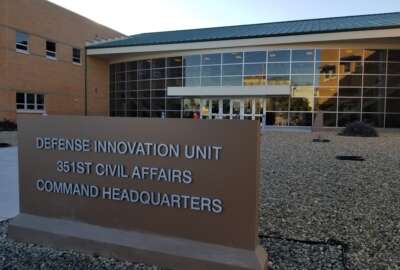Hubbard Radio Washington DC, LLC. All rights reserved. This website is not intended for users located within the European Economic Area.
DoD extends civilian hiring restrictions through 2018
Pentagon hiring freeze for civilian employees will last several more years, although Defense Department leaders say they'll grant exemptions to give the departm...
wfedstaff | April 17, 2015 4:00 pm
The Defense Department intends to continue a wide-ranging freeze on the growth of its civilian workforce for at least six more years, according to documents the Pentagon drafted in preparation for the budget proposal it will release next year.
The DoD comptroller’s guidance to military components ordered that current targets for civilian personnel, based on 2010 staffing levels, will remain in effect through 2018. An earlier memo obtained by Federal News Radio said the department would seek to hold service contractor personnel at levels 30 percent below what the department paid for in 2010. That target also will apply through 2018.
The directives have gotten the attention of Capitol Hill. Both sides of the aisle are concerned that the DoD is setting arbitrary civilian “caps” without analyzing the work it needs its non-uniformed workforce to perform.
Rep. Randy Forbes (R-Va.) suggested the policies also might contradict previously-enacted laws prohibiting the department from setting a maximum number of civilian employees.
“Does the cap presume that the budget is driving the DoD’s civilian workforce requirements, or vice-versa?” Forbes asked at an Armed Services readiness subcommittee hearing Wednesday.
It’s not quite a cap
Frederick Vollrath, the Pentagon’s principal deputy assistant secretary for readiness and force management, insisted the notion of a “cap” is a misnomer.

In a statement to Federal News Radio, Pentagon spokeswoman Cynthia Smith reiterated that there is no hard cap. The 2010 workforce levels are merely a “departure point” for prioritizing the DoD’s workforce, and the Pentagon frequently issues waivers.
The size of the civilian workforce still will vary from year to year based on a balance of mission, workload and available budget resources, Smith said.
The DoD has indicated in recent directives that more guidance on the waiver process is forthcoming. But federal labor unions contend that so far the process has been tailored in such a way those exceptions to the restrictions have been few and far between.
Jay Aronowitz, the Army’s deputy assistant secretary for force management, offered a glimpse of the effects of the civilian hiring restrictions in response to questions from the Senate Homeland Security and Governmental Affairs Committee in March.
“The civilian workforce cap…limits the flexibility that the Army has, both as a whole and in individual components when managing its manpower mix,” he wrote. “If a civilian cannot be hired, then the only remaining options are to contract the function or use borrowed military manpower. The use of military personnel is usually not an option, which leaves only contracting as a viable means of executing a mission.”
Nothing new, nothing borrowed
Vollrath told lawmakers Wednesday he too was concerned about forcing commanders to “siphon off” military personnel for work that would otherwise be performed by civilians, and that the department was trying to avoid letting that happen.
“We’ve put out guidance that tells the components to be very attuned to the shaping of the force so as not to make decisions that could result in borrowed military manpower,” he said. “If you don’t properly identify the civilian workforce that you need, the probability goes up that military might be sent in to fill that gap. We are keenly aware of the historic problems that the problems that happen when we do these kinds of downsizings.”
Lawmakers had other worries about the civilian workforce however, including concerns that the DoD’s human capital management strategy is less than optimal in terms of understanding the department’s workforce requirements, whether it can identify the skills already at its disposal and determining the right mix of civilian, military and contractor personnel it needs to meet its missions.
But Vollrath said the department has made major progress in recent years including developing a better understanding of the size of its contractor workforce. He told lawmakers the Pentagon finally has a system to count the number of service contractors working for DoD and will implement it soon.
“[An] inventory of contract services was not robustly supported in the past,” he said. “We now believe we have that built, along with information technology support, and it will let us get a much better handle on what we are getting for those contract services that we’ve let. Our real focus frankly is to get a handle on our civilian workforce and its projected requirements. I can’t tell you we’ll have this all figured out by 2015 because it’s always a moving target, but we believe we have tools in place or about to be in place that will let us shape the force better than we’ve ever been able to do in the past.”
According to the Government Accountability Office, the DoD has put together a list of 22 of its most critical skills after five years of congressional prodding. They include contracting, accounting and information technology management.
But while the DoD now knows what it most wants from its civilian workforce, the GAO’s chief critique is that the department still doesn’t have a way of measuring how well those skills already are represented in the ranks, and conversely, where there are gaps.
Figuring out the holes in the workforce
Vollrath said the department had begun working on such a “gap analysis.” But without that study, the Pentagon will risk repeating some of the civilian workforce mistakes it made in the 1990s, the GAO worries.

Vollrath said he, too, wants to avoid poorly-thought-out workforce shakeups. He served as a senior Army officer responsible for military personnel in the 1990s, and thinks the Pentagon can do better this time.
“I lived that dream of trying to downsize the force. It’s not an easy task,” he said.
He said the department is committed to finding the right balance between military, civilian and contractor personnel. And in some specific areas, that workforce strategy might well lead to a surge in civilian hiring.
“For example, cyber. If [you] went back about five years, cyber was barely a term. It’s now come to the front. The federal civilian workforce is a real opportunity for us because we can hire people with those kinds of skills into the mid-grades,” he said. “On the military side, if we want to build that kind of competency, we have to bring them in, train them and grow them over time. The civilian workforce of the Department of Defense is critical to national defense.”
Members also grilled Vollrath on how sequestration would impact the civilian workforce and whether he had begun planning for the automatic budget cuts. He said he had not, and a decision to begin planning would be up to Secretary of Defense Leon Panetta. If sequestration should occur, DoD would have to alert Congress 105 days before any reductions in force could occur, and that the military would have to study how it would rebalance its military, civilian and contractor workforce.
Completing such a review would take at least three to four months and it hasn’t been started yet, Vollrath said. When pressed by Forbes as to why, he repeatedly deferred to an Aug. 1 hearing in which Deputy Defense Secretary Ashton Carter is scheduled to brief lawmakers with more details on how the DoD would implement sequestration.
In the meantime, Congress is relying on the Budget Control Act as a guide. Forbes said up to a quarter of the department’s civilian workforce, or 200,000 employees, may need to be cut under sequestration, citing private estimates from the Pentagon.
“The result of any such cuts, particularly without analytical underpinning, would be long-term, irreversible damage,” he said.
Federal News Radio intern Esther Carey contributed to this report.
RELATED STORIES:
Senate Dems call for service contracting caps, but industry cries foul
Senators cancel reductions to Air National Guard, cut DoD civilians
Defense cuts could hit civilian workforce
Copyright © 2024 Federal News Network. All rights reserved. This website is not intended for users located within the European Economic Area.
Jared Serbu
Jared Serbu is deputy editor of Federal News Network and reports on the Defense Department’s contracting, legislative, workforce and IT issues.
Follow @jserbuWFED
-
A look at the origins of the Defense Innovation Unit Federal Drive
-
GAO reviews how the VA is training its claim processors Federal Drive





